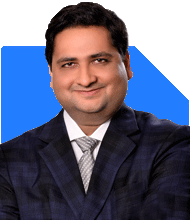Hardik Parikh | Answer |Ask -Follow
Tax, Mutual Fund Expert - Answered on Apr 25, 2023
He also holds an MBA degree from IIM-Indore.
Hardik, who began his career as an equity research analyst, founded his own advisory firm, Hardik Parikh Associates LLP, which provides a variety of financial services to clients.
He is committed to sharing his knowledge and helping others learn more about finance. He also speaks about valuation at different forums, such as study groups of the Western India Regional Council of Chartered Accountants.... more

Hi Sir, Thanks for your response and suggestion. I have few queries. Can you please provide me response to my queries. I am investing in the following mutual funds. Do I need to swap my funds: 1. Canara Robeco equity hybrid fund- Growth 2. Axis bluechip fund - Growth 3. Mirae Asset Equity Allocator Fund of Fund - Growth 4. DSP equity and bond fund - Growth I have invested money in following I dian companies. Do I need to shift my funds to other companies: Reliance, Infosys, L&t, Titan, Vedanta, Hindustan Zinc, Rec, HDFC Bank, ITC and Kalyan Jewellers. My current Real Estate value in Bangalore is currently around 3 crores. With this I think I will be able to achieve my target of 5 Crores for retirement in next 10 years. Above this I have invested in Lic ( 20 L) which will mature in 2025, pension plan, sukhanya samrudhi, 1 Cr term life insurance and 20L medical insurance which I have not included in my retirement plan. Also how much money is required monthly for a good retirement life. Currently my assets ( Rent, FD, agriculture etc) is yielding me around 75000 rupees/ month. With my assets and income whether I can live a comfortable life post retirement? Regards, Krishna
Thank you for reaching out with your queries. It's great to see that you have a diversified investment portfolio and are planning for your retirement. Based on your investments and goals, I have a few recommendations for you.
Regarding your mutual funds, it seems that you have a good mix of equity and debt funds. While I cannot make specific recommendations without a detailed analysis of your risk tolerance, investment horizon, and financial objectives, it is crucial to review the performance of your funds periodically. If any of your funds consistently underperform compared to their respective benchmarks or category peers, you may want to consider reallocating to better-performing funds.
In terms of your stock investments, while it's essential to maintain a diversified portfolio, it might be prudent to shift away from cyclical stocks like Vedanta and Hindustan Zinc. Cyclical stocks are often sensitive to economic fluctuations, and it's better to focus on stable, high-quality companies with a good growth potential for long-term investments, particularly as you approach retirement.
Once your LIC policy matures in 2025, I suggest reallocating the proceeds into more liquid investments that can provide stable returns. You could consider investing in debt mutual funds, fixed deposits, or even high-dividend-yielding stocks. These investments would help you maintain a balance between capital preservation and income generation during your retirement years.
As for the amount required for a comfortable retirement, this will depend on various factors, including your lifestyle, healthcare needs, and inflation. You may want to consider working with a financial planner to calculate the exact amount required based on your unique circumstances. However, based on your current assets and income of ₹75,000 per month, it seems that you are on track to achieving your retirement goal of ₹5 crores in the next 10 years.
Remember that it's important to periodically review and rebalance your investments to ensure that you remain on track to meet your financial goals.
Best regards,
You may like to see similar questions and answers below
Ramalingam Kalirajan |10872 Answers |Ask -Follow
Mutual Funds, Financial Planning Expert - Answered on Jun 04, 2024
Ramalingam Kalirajan |10872 Answers |Ask -Follow
Mutual Funds, Financial Planning Expert - Answered on Sep 30, 2024
Reetika Sharma |417 Answers |Ask -Follow
Financial Planner, MF and Insurance Expert - Answered on Nov 07, 2025
Radheshyam Zanwar |6735 Answers |Ask -Follow
MHT-CET, IIT-JEE, NEET-UG Expert - Answered on Dec 06, 2025
Dr Nagarajan J S K |2576 Answers |Ask -Follow
NEET, Medical, Pharmacy Careers - Answered on Dec 06, 2025
Mihir Tanna |1090 Answers |Ask -Follow
Tax Expert - Answered on Dec 06, 2025
Ramalingam Kalirajan |10872 Answers |Ask -Follow
Mutual Funds, Financial Planning Expert - Answered on Dec 06, 2025
Radheshyam Zanwar |6735 Answers |Ask -Follow
MHT-CET, IIT-JEE, NEET-UG Expert - Answered on Dec 06, 2025
Radheshyam Zanwar |6735 Answers |Ask -Follow
MHT-CET, IIT-JEE, NEET-UG Expert - Answered on Dec 06, 2025
Radheshyam Zanwar |6735 Answers |Ask -Follow
MHT-CET, IIT-JEE, NEET-UG Expert - Answered on Dec 06, 2025
Dr Dipankar Dutta |1837 Answers |Ask -Follow
Tech Careers and Skill Development Expert - Answered on Dec 05, 2025
Dr Shyam Jamalabad |108 Answers |Ask -Follow
Dentist - Answered on Dec 05, 2025
Dr Shyam Jamalabad |108 Answers |Ask -Follow
Dentist - Answered on Dec 05, 2025



























